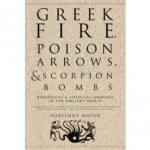 by Adrienne Mayor (Wonders & Marvels contributor)
by Adrienne Mayor (Wonders & Marvels contributor)
Have you ever been pepper-sprayed or tear-gassed? You can create the experience on a small scale by frying fiery-hot jalapeños in oil and then fleeing your smoke-filled kitchen. Oleoresin capsicum inflames eyes, nose, and throat, causing searing pain, restricted airways, and temporary blindness. Tear gas, a volatile solvent invented in the 1920s, has the same incapacitating effects. These two “non-lethal” chemical agents wielded for crowd control are both prohibited in warfare by the 1997 Chemical Weapons Convention.
As our stovetop experiment demonstrates, the ability to create a choking cloud of smoke is available to anyone with access to chilis scoring high on the Scoville Heat Index (units measuring Capsicum fire power). Imported from the New World to Asia by the Spanish, hot peppers became indispensable to local cuisines. But peppers could also be weaponized, as the Conquistadors learned. In the 16th and 17th centuries, Caribbeans and Brazilians set fire to hot pepper seeds and let the wind envelop their enemies in clouds of pungent smoke.
Asphyxiating chemical fumes were devised in antiquity, anticipating pepper spray and tear gas by 2,500 years. The Spartans deployed deadly sulfur dioxide gas in 429 BC. In 80 BC, the Roman commander Sertorius defeated rebels holed up in impregnable limestone caverns with an ancient version of tear gas. Noticing that his horse kicked up clouds of caustic lime dust, Sertorius piled up heaps of the white powder in front of the caves. As the prevailing north wind gathered force, the Romans stirred the mounds, raising great clouds that blew directly into the caves. Like tear gas, limestone or gypsum dust becomes extremely corrosive on contact with moist mucus membranes. The rebels surrendered.
A peasant revolt in China was suppressed in AD 178 with the same chemical agent, now delivered by new technology. The emperors’ forces manned “lime chariots” equipped with bellows to blast caustic lime powder “according to the wind” into the crowds of protestors.
All three ancient examples depended on friendly winds to avoid blowback, a perpetual problem for those who resort to biochemical weapons. Before the invention of gas masks, kerchiefs soaked in vinegar neutralized noxious fumes, an ancient technique still used by experienced demonstrators facing tear gas and pepper spray today.

About the author: Adrienne Mayor is a Research Scholar in Classics and History of Science, Stanford University. She is the author of “Greek Fire, Poison Arrows & Scorpion Bombs: Biological and Chemical Warfare in the Ancient World” (2009) and “The Poison King: The Life and Legend of Mithradates, Rome’s Deadliest Enemy,” a nonfiction finalist for the 2009 National Book Award.
